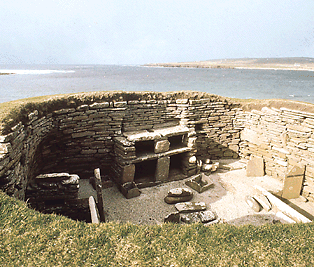“Frankenstein” Mummies Found in Scotland
Wednesday, July 18th, 2012July 18, 2012
Mummies created over several hundred years from the body parts of different individuals have upended archaeologists’ ideas about the treatment of the dead in prehistoric Britain. The mummies, which are at least 3,000 years old, were discovered beneath the foundations of a prehistoric house on South Uist, an island off the western coast of Scotland in the Outer Hebrides. The two bodies are the first direct evidence of mummification in the ancient Old World outside of Egypt.
Archaeologists found the mummies in 2001 while excavating a village, known as Cladh Hallan, that was inhabited from 2200 to 800 B.C. Workers had already discovered the skeletons of a teenaged girl and a 3-year-old child when they came upon two unusual-looking skeletons. These remains–those of an adult man and an adult woman–were curled in a tight fetal position similar to that found in Inca “mummy bundles” from prehistoric South America. Such bundles consist of a body and personal effects wrapped in layers of colorful cloth. Changes in the mineral composition of the outer layers of the bones indicated that the bodies had been intentionally preserved, likely in the acidic environment of a peat bog, for at least one year. Soil and water conditions in a peat bog greatly slow the decay of organic (biological) matter. No intentionally mummified bodies had ever been found before in prehistoric Europe. Since then, archaeologists have found two additional human mummies in England. Holes drilled in the long bones of the arms and legs suggest that the skeletons of these mummies had been strung together.

The ancient settlement of Cladh Hallan, where the composite mummies were found, probably looked similar to Skara Brae (above), a 5,000-year-old village found in the Orkney Islands in Scotland. (Scottish Tourist Board)
While examining the adult skeletons from Cladh Hallan, archaeologists were extremely suprised to discover that the bones actually came from different individuals. The female skeleton consists of a lower jaw from one person; an upper arm bone from another; and a thighbone from a third. The male skeleton consists of a torso and limbs from one person; a skull and neck from a second; and a lower jaw from a third. A DNA analysis of the bones confirmed this finding. Moreover, the skeletons had been assembled over a period of several hundred years–from 1260 to 1440 B.C. and from 1130 to 1310 B.C.
Archaeologist Mike Parker-Pearson of the University of Sheffield, who led the excavation, speculated that the composite skeletons may have been assembled for ceremonial reasons. Another possibility is that they could represent “the merging of different families and their lines of descent,” at a time when ownership of the land was communal rather than private.
Additional World Book articles:
- Bog bodies
- Scotland (Prehistoric Scotland)
- Medical Tales from the Crypt (a Special Report)
- Archaeology 1985 (a Back in Time article)


